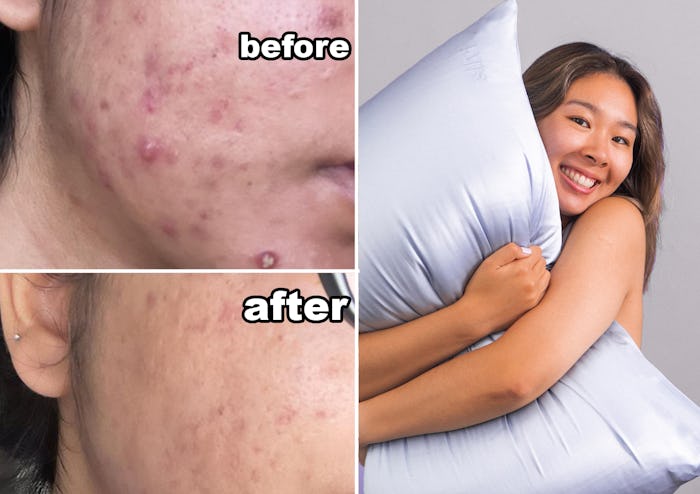Shopping

I Tried An Anti-Acne Pillowcase For My Acne-Prone Skin — Here Are My Honest Thoughts
We only recommend products we love and that we think you will, too. We may receive a portion of sales from products purchased from this article, which was written by our Commerce team.
If you struggle with acne-prone skin, you’re probably no stranger to “miracle” products that promise to clear your skin. I’m with you. It feels like I’ve tried everything, from expensive chemical peels to over-the-counter retinols to hemp-based clay masks. But something I had never tried? A silk pillowcase designed with silver in the fabric for anti-bacterial and antimicrobial benefits. Enter Silvi’s anti-acne silk pillowcase. When I stumbled upon Silvi’s silk pillowcase I knew I had to try it for myself.
There’s a lot of lore around silk pillowcases for people with acne-prone skin. And, while dermatologists are quick to remind that the frequency with which you wash your pillowcase is more important than the material, there’s a lot of anecdotal support for silk fabric. Skin care experts and beauty fans often report that their hair and skin is less irritated when they sleep on smooth fabrics like silk. After having tried a lot of silk pillowcases, I can say they really do feel luxurious and smooth to sleep on.
Silvi’s silk pillowcase is made of 22-momme silk with grade 6A fibers, the highest quality grade given to fibers. For those new to the world of silk, the fabric is measured by the weight of it, which is measured in mommes. Most silk pillowcases range from 19 to 25 mommes, and Silvi’s sits squarely in the middle at 22 mommes. While in theory, the higher the momme weight, the better quality the silk is, those with acne-prone skin should be wary of thicker silk. Thicker silk is usually harder to care for, and since you’ll need to frequently clean any pillowcase if you have acne-prone skin, a lower momme weight silk that is machine-washable (like Silvi’s pillowcase), is a much better purchase.
The pillowcase is made of silver?
What really sets this pillowcase apart is their SilvTech™ fabric, which is designed with silver ion technology. Research has proven that silver has antimicrobial properties, and Silvi’s pillowcase promises to reduce bacteria on the surface of your pillow by 99.7%. While most dermatologists advise you wash your pillowcase at least once a week if you struggle with acne, Silvi’s pillowcase can go nearly two weeks between washes. And, while I’m naturally skeptical of lofty, acne-clearing claims, so many reviewers testify that this pillowcase has improved their acne.
One customer says, “I have been using the Silvi anti-acne pillow case for a few weeks now. I have seen a change in my skin since using it. Paired with a good skin care routine and my skin has never looked better!! It is so comfortable to sleep on and makes my skin feel like it’s sleeping on something that isn’t full of bacteria. Highly recommend the Silvi anti acne pillow case.”
After having slept on this pillowcase, I can attest to how high quality the silk feels. I’ve tested out silk pillowcases that cost more than twice as much as the Silvi pillowcase, and the value you’re getting with this pillowcase is great. It feels luxurious and soft to sleep on and was easy to wash in my washing machine on delicate.
Can a pillowcase clear your acne?
It’s still a little too early for me to declare this pillowcase as a miracle cure for anyone with acne, myself included. However, if your journey with your acne-prone skin feels like it’s never-ending, examining your pillowcase and how often you clean it is a really smart idea. While personally my acne is an ongoing struggle, I can’t help but feel a little better equip to handle it now that I have a pillowcase that isn’t working against me. And, since Silvi has a 100-night free trial, I’m excited to try it and see how my skin improves over the longterm.
This article was originally published on